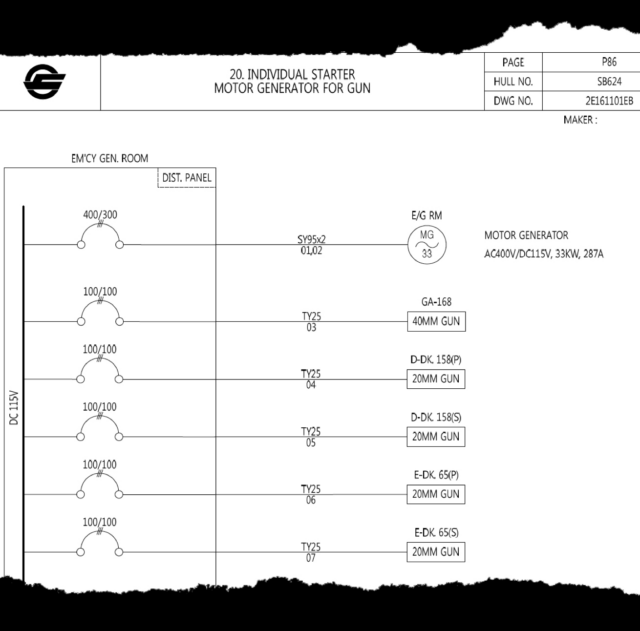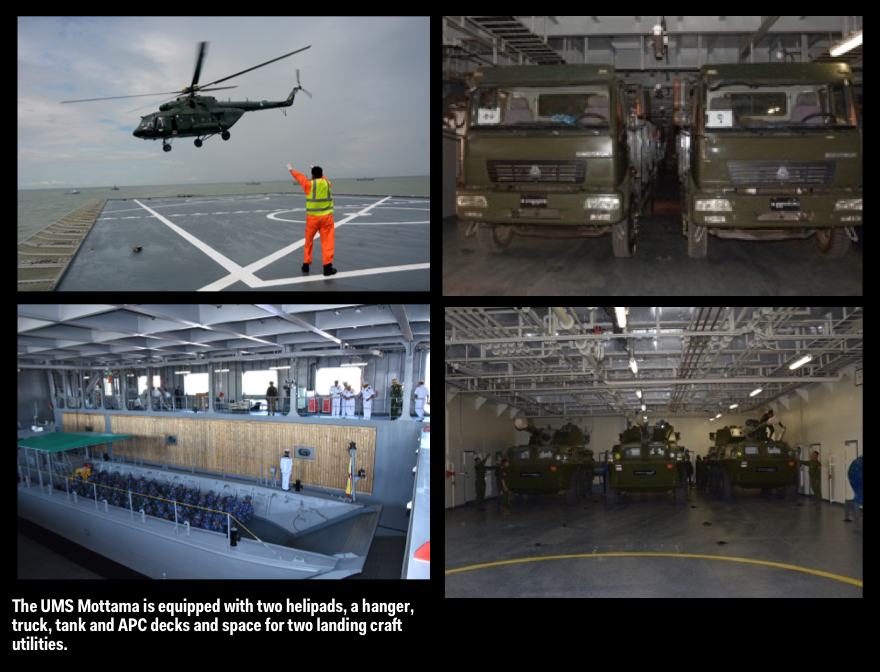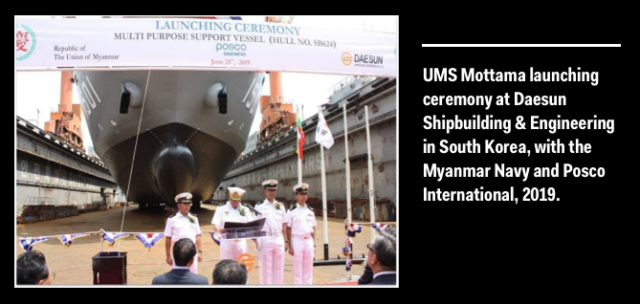Justice for Myanmar and Korean Civil Society in Support of Democracy in Myanmar Call for Swift Indictment over Transfer of US$ 42M Korean Warship

Published with Korean Civil Society in Support of Democracy in Myanmar
Justice For Myanmar and Korean Civil Society in Support of Democracy in Myanmar welcome recent developments in the police investigation of Posco International, Daesun Shipbuilding & Engineering and Korea’s Ministry of Defense over the 2019 transfer of a warship to the Myanmar Navy.
We call on South Korea’s public prosecutor to take swift action to indict the individuals responsible for the alleged violation of Korea’s Foreign Trade Act.
Legal proceedings are an important step towards accountability for the transfer of arms to the Myanmar military, and to prevent future arms transfers from the Republic of Korea.
South Korea’s illegal arms exports to Myanmar
In 2017, Daesun Shipbuilding & Engineering, which was then majority-owned by Korea’s state-owned Eximbank, requested permission to export a Landing Platform Dock (LPD). An LPD is an amphibious assault ship designed to transport and land troops and equipment for military operations.
South Korea’s Defense Acquisition Program Administration of the Ministry of Defense denied export approval, in accordance with Korean law and Korea’s obligations under the Arms Trade Treaty.
However, five months later, Posco International filed an amended export request for a ‘Multi-Purpose Support Vessel (MPSV)’, to be used for humanitarian assistance and disaster response and which it claimed would be built to civilian specifications. The Ministry of Defense approved the export, knowing that the user was the Myanmar Navy and that the navy had already attempted to procure an amphibious assault ship.
A leaked 2017 meeting notification from the Commander-in-Chief (Navy) to the Myanmar Army’s Directorate of Procurement states that the planned MPSV acquisition was proposed by Posco International, which was then called Posco Daewoo. The meeting took place as the Myanmar military was committing genocide against the Rohingya.
Evidence formally submitted to South Korean police by Chief Petty Officer Myat Min Thu, a member of the Civil Disobedience Movement from the Myanmar Navy, proves that the ship was built as an amphibious assault ship for military use, according to the original plan, and that the MPSV designs submitted by Posco International for export approval were false.
Myat Min Thu was a former crew member of the LPD and attended training in South Korea. He joined the Civil Disobedience Movement shortly after the military’s illegal coup attempt, taking a trove of evidence related to the LPD with him.
Ship designs shared by Myat Min Thu with Justice For Myanmar, Korean Civil Society in Support of Democracy in Myanmar and Myanmar Now, and made public for the first time, show that five guns were included in the ship plans. The documents were produced by Daesun Shipbuilding and metadata shows they were created in 2018, after export approval was granted for the building of a civilian vessel. While the guns were mounted after the ship was transferred to Myanmar in 2019, the electrical and communications systems for the guns were installed in South Korea by Daesun Shipbuilding & Engineering, according to the leaked plans.

Leaked documents also show that the ship was designed to transport and launch troops and military equipment:
- F deck was designed to transport 69 officers and includes one VIP room.
- G deck was designed to transport 261 troops and up to three helicopters. It has two helipads, and a hanger that can hold one aircraft, such as a Mi-2, Bell-412 or Airbus Eurocopter AS365. The LPD can temporarily land a Mi-17.
- H deck was designed to transport 45 troops and 13-15 Sinotruk or Tata trucks.
- J deck was designed to carry 182 troops.
- K deck was designed to carry 12 T-72S tanks and 4 BTR-3U armoured personnel carriers.
The ship design includes vehicle lashings made to meet the specifications of the Myanmar Army’s fleet of trucks, tanks and armoured personnel carriers, a vehicle lift and a well dock for two 23 metre landing craft.

According to evidence shared by Myat Min Thu, the cost of the ship was US$42.3 million.
In November 2020, Justice For Myanmar, Korean Civil Society in Solidarity with Rohingya and Korean Transnational Corporation Watch filed complaints with the OECD National Contact Point in Korea and the National Human Rights Commission of Korea against Daesun Shipbuilding & Engineering, Posco International and other businesses supporting the Myanmar military.
The complaint led to scrutiny of the LPD export and police opened an investigation. The police investigation was later supported through the cooperation of Myat Min Thu.
Following reporting by the Korean broadcaster MBC in 2021, the Defense Acquisition Program Administration issued a statement expressing “deep regret” over the export of the LPD to Myanmar, pledging to strengthen export screening and to discuss designating countries that have violated export agreements. However, the Ministry of Defense did not address how they came to approve the amended export application and allow the transfer of a warship to the Myanmar military, which commits atrocity crimes with total impunity.
The LPD was transferred to Myanmar following the 2017 campaign of genocide against the Rohingya, in which the Myanmar Navy took part. Myanmar Navy personnel travelled to Korea in June 2019 for the launching ceremony, which was held with Posco International and Daesun Shipbuilding & Engineering.

The LPD was commissioned as the UMS Mottama (1501) in a ceremony in 2019 involving Min Aung Hlaing. Video of the ceremony shows the ship filled with soldiers, special forces, tanks and armoured personnel carriers, ready to launch an attack, consistent with the design documents.
Earlier this year, Janes reported that the Myanmar military was using the Mottama to support its troop build-up in Rakhine State, which has involved the commission of atrocity crimes.
Posco International is a longstanding business partner of the Myanmar military. Posco International operates the Shwe gas project and invests in a pipeline that transports gas to China. The project is one of the biggest sources of foreign revenue for the Myanmar junta.
Posco International is also the lead investor in Lotte Hotel Yangon, a real estate development on land leased from the US-sanctioned Office of the Quartermaster General of the Myanmar army.
In 2006, Posco International, under its former name, Daewoo International, illegally exported machinery and technology for the manufacture of cannons by the Myanmar military’s Directorate of Defence Industries. 14 people from Daewoo International were indicted, including the company’s president, Lee Tae Yong.
The transfer of the LPD shows that Posco International’s support for the Myanmar military has continued. We call on South Korean authorities to hold all those responsible for the LPD export to account, and take decisive steps to prevent Korean companies from supporting the Myanmar military junta.
Explore the evidence
General arrangement plan: Download PDF (1.21 mb)
Arrangement of cargo lashing: Download PDF (777 kb)
Arrangement of helicopter traveling system: Download PDF (1.12 mb)
Arrangement of deckwell: Download PDF (807 kb)
Wiring diagram of power system: Download PDF (3.62 mb)
Wiring diagram of electrical equipment in ECR: Download PDF (416 kb)
Wiring diagram of control and monitoring system: Download PDF (1.57)
Wiring diagram for navigation & communication system: Download PDF (2.22 mb)
Technical specification of turn table: Download PDF (2.7 mb)
Technical specifications of cargo access equipment: Download PDF (4.67 mb)
Extract from UMS Mottama databook: Download PDF (4.2 mb)
Technical specification for multi purpose support vessel (1 December 2017): Download PDF (843 kb)
Letter from Myanmar Navy to the Directorate of Procurement (27 October 2017): Download PDF (100 kb)

